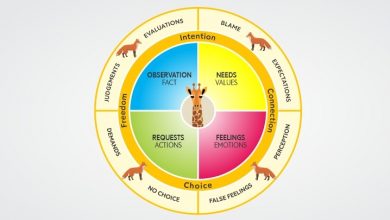Step Two Exercise
The Step Two Exercise is a series of questions to practice imagining how someone else might be feeling when that person is not clearly expressing their emotions.

Why did I choose this tool?
This is one of the foundational exercises in my personal work. It has helped me realize what people might be struggling with and within seconds, helps me have a better emotional connection to them. It has helped me reframe relationships with my ex-girlfriend, my mother, my best friend, my ex-boss, and many others. It has helped me disarm conflicts. I like it because it is very simple and quick. It also can be challenging, because often we don’t think of how some of these people would feel about certain things.
How does this apply to being a trainer?
As a trainer, sometimes participants will hesitate to express emotions to us as an authority, especially if it’s a “negative” emotion in their mind, so this exercise can help us imagine how they may be feeling and help empathize with them regardless. Instead of just giving us something to read, this article gives us something to practice, because at the end of the day, to gain a skill, I believe we need to practice using that skill. This skill will not only be helpful for uncovering what may be unexpressed with the participants, but also with our fellow trainers as well. In the trainer role, often we focus so much on the participants that we forget to imagine what our fellow trainers may be experiencing. I remember on one of my projects, one of the trainers was struggling with two very recent deaths in the family, and while I knew he was going through that, I forgot about it during the week, noticed how the participants were treating him poorly and how he was avoiding a lot of contact with them, and then only at the end of the week remembered to imagine what he might have been feeling when he was there.
Content
Step two comes from a process I’ve developed that I simply call the Three Steps:
Step 1: TRUTH
Step 2: FAIR PLAY
Step 3: LOVE
Step 1 is about truth—telling the truth about how we actually feel in the moment. When we do this, the other person starts to trust us more and we emotionally connect to ourselves.
Step 2 is about fair play—telling the other person how we imagine they might be feeling. When we do this, we start to show the other person that we’re considering their emotions, that we don’t know how they feel, and we emotionally connect to them.
Step 3 is about love—saying one thing to the other person to connect with love. When we do this, we affirm to the other person our connection and that we care about them and we emotionally connect to each other.
The exercise for Step 2 is the following:
- Choose a person in our life (family member, participant, fellow trainer, friend, etc.) for whom we will do this exercise.
- Set a timer for 3 minutes.
- In our head, ask ourselves a series of questions with the format: “How do I imagine this person might feel when they think about ____?”
- In the blank, put in any situation we would like, related or not related to training:
- “How do I imagine this person might feel when they think about speaking in front of 100 people?”
- “How do I imagine this person might feel when they think about cooking for 100 people?”
- “How do I imagine this person might feel when they think about receiving feedback from me?”
- “How do I imagine this person might feel when they think about leaving this training?”
- “How do I imagine this person might feel when they think about running a trust-fall workshop?”
- In the blank, put in any situation we would like, related or not related to training:
- When answering the questions, try to say a word or phrase that expresses the emotion the person might be feeling.
- When the timer finishes, reflect on what we learned.
One key principle to remember is to imagine what they might be feeling, not what we know that they are feeling. The underlying logic is that we may have an idea what somebody might be feeling, as we see signs of it in things like their facial expressions, posture, and tone of voice, and yet we are not 100% certain which word they would use to describe those feelings. If we think they’re angry and they think they’re annoyed, it could lead to a disagreement. The second point of underlying logic is that we also do not know why they’re feeling that way. We may assume that it’s because of one aspect, like the training going too long, but it may be because of something happening in another realm of their life. Remembering to emphasize the uncertainty helps us imagine their emotional states and remember that they are a living breathing human who feels lots of things and who is trying their best to make it in the world.
How does this relate to unexpressed concerns, feelings, and emotions?
The essence of this activity is imagining what concerns, feelings, and emotions are unexpressed. First, rarely will someone express the full range of what’s going on with them. Second, I’m not even sure it’s possible for someone to articulate all of their concerns, feelings, and emotions. This exercise allows us to practice the skill at imagining what may be affecting the other individual without requiring them to express the issues openly. I believe that the better we get at seeing the possible concerns they may have, the more confident and prepared we can be to have the conversations with them to learn more about what concerns they’re actually having.
What are some examples of concerns, feelings, and emotions that go unexpressed and how they impact the training environment?
- A participant feels frustrated that they had to miss their friend’s wedding to attend the training and then spreads that frustration in their working group—but they think she just doesn’t like them.
- A trainer has an urgent deadline for another job back home and is going in and out of the training room all the time to work on the project—but the participants don’t know why he’s leaving and just think he doesn’t care about them.
- One participant gives a presentation about how much their family means to them, and another participant, who just lost their father, starts crying and runs out of the room—but the presenter thinks he did something wrong.
- A participant is introverted and feels a lot of social anxiety around new people—but the other participants believe that he thinks he’s better than everyone.
- A trainer is feeling sick and vomiting in the morning and thus has little patience with the participants in the workshop—but they think she is frustrated with how slowly they’re learning.
- A participant just lost a friend to suicide and doesn’t interact with many of the other participants—but the participants think he is just shy or not confident in his language skills.
- A trainer falls in love with one of the trainers, and therefore doesn’t spend much time with the other trainers—but the other trainers think she just doesn’t like working with them.
Closing
We will never know everything that is going on in another person’s life, even if they are very open with us. With practice, we can get better at imagining the variety of things they may be thinking, feeling, and experiencing, so that we can connect with them on a deeper and deeper level.
Reflection Questions:
- For which people would this exercise be easy for you to do?
- For which people would this exercise be difficult for you to do?
- Have you done any related activities to this? If so, what?
- What’s one emotion that you struggle to imagine them feeling?
- What’s one emotion that you often imagine that they’re feeling?
- How often do you say to someone, “I know you’re feeling X” or “Why are you so angry?”
- What is one example of a concern, feeling, or emotion that you didn’t express on a training and how did that impact the training environment?
- What is one example of a concern, feeling, or emotion that someone else did not express on a training and how did that impact the training environment?
- What are some emotional burdens that you think participants bring to a training and don’t want to express?
- What are some emotional burdens that you think trainers bring to a training and don’t want to express?
- What are some emotional burdens that you might bring to a training and not want to express?
Exercises:
How to apply it in everyday life
- Record yourself asking the questions and then play it back, so that you can first focus on asking and then on answering when playing it back.
- Try this exercise with another person, where they ask you these questions for 1 minute, and then you switch and you ask them, and then you switch 5 times, for a total of 10 minutes.
- Next time you KNOW how someone is feeling, try communicating using the step two of how you imagine they might be feeling—”I imagine you might be feeling frustrated with this right now” vs “I know you’re feeling frustrated with this right now.”
- Record yourself asking the questions and then get into a group of people and play it back, where you all reflect on how you imagine the same person might feel when thinking about the different scenarios.
- Try the exercise asking questions related to different themes, for example:
- The logistics of the training (e.g., when they think about eating the food on the training, when they think about sleeping in the rooms, when they think about following the directions to arrive to the venue, etc.)
- The overall training (e.g., when they think about interacting with the other participants, when they think about creating a follow-up project, when they think about sharing how the training went with others back home, etc.)
- The person’s career (e.g., when they think about applying for jobs, when they think about their current CV, when they think about looking for mentors, etc.)





